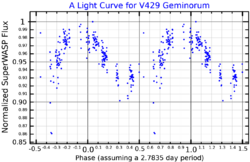Astronomy:V429 Geminorum
V429 Geminorum (BD+20°1790) is a young orange dwarf star in the constellation Gemini, located 90 light years away from the Sun. It is a BY Draconis variable, a cool dwarf which varies rapidly in brightness as it rotates.
Description
The star is young and very active and is a member of the AB Doradus Moving Group.[7] The star has also been studied and monitored by SuperWASP group and found to coincide with the ROSAT source 1RXS J072343.6+202500.[1] The planet candidate was announced in December 2009.[5]
Disproven planet
The Keplerian fit of the radial velocity data suggested an orbital solution for a close-in massive planet with an orbital period of 7.7834 days. Moreover, the presence of a close-in massive jovian planet could explain the high level of stellar activity detected.[5] However, further study suggests that this planet does not exist because the radial velocity variations are strongly correlated to stellar activity, suggesting this activity is the cause of the variations.[8][9] This echoes the similar case of the disproven planet detection around TW Hydrae, which was also found to be due to stellar activity rather than orbital motion.[10]
References
- ↑ 1.0 1.1 Norton; Wheatley, P. J.; West, R. G.; Haswell, C. A.; Street, R. A.; Collier Cameron, A.; Christian, D. J.; Clarkson, W. I. et al. (2007). "New periodic variable stars coincident with ROSAT sources discovered using SuperWASP". Astronomy and Astrophysics 467 (2): 785–905. doi:10.1051/0004-6361:20077084. Bibcode: 2007A&A...467..785N.
- ↑ 2.0 2.1 2.2 2.3 2.4 Vallenari, A. et al. (2022). "Gaia Data Release 3. Summary of the content and survey properties". Astronomy & Astrophysics. doi:10.1051/0004-6361/202243940 Gaia DR3 record for this source at VizieR.
- ↑ 3.0 3.1 Samus, N. N. et al. (2009). "VizieR Online Data Catalog: General Catalogue of Variable Stars (Samus+ 2007-2013)". VizieR On-line Data Catalog: B/GCVS. Originally Published in: 2009yCat....102025S 1. Bibcode: 2009yCat....102025S.
- ↑ Torres & Quast; Quast, G. R.; Melo, C. H. F.; Sterzik, M. F. (2008). "Young Nearby Loose Associations". Handbook of Star Forming Regions, Volume II: The Southern Sky ASP Monograph Publications 5: 1–757. Bibcode: 2008hsf2.book..757T.
- ↑ 5.0 5.1 5.2 5.3 5.4 5.5 5.6 5.7 5.8 5.9 Hernán-Obispo et al. (2009). "Evidence of a massive planet candidate orbiting the young active K5V star BD+20 1790". Astronomy and Astrophysics 0912: A45. doi:10.1051/0004-6361/200811000. Bibcode: 2010A&A...512A..45H.
- ↑ Carpenter; Bouwman, Jeroen; Mamajek, Eric E.; Meyer, Michael R.; Hillenbrand, Lynne A.; Backman, Dana E.; Henning, Thomas; Hines, Dean C. et al. (2009). "Formation and Evolution of Planetary Systems: Properties of Debris Dust Around Solar-Type Stars". The Astrophysical Journal Supplement 181 (1): 197–226. doi:10.1088/0067-0049/181/1/197. Bibcode: 2009ApJS..181..197C.
- ↑ Lopez-Santiago et al. (2006). "The Nearest Young Moving Groups". The Astrophysical Journal 643 (2): 1160–1165. doi:10.1086/503183. Bibcode: 2006ApJ...643.1160L.
- ↑ Figueira et al. (2010). "Evidence against the young hot-Jupiter around BD +20 1790". Astronomy and Astrophysics 513: L8. doi:10.1051/0004-6361/201014323. Bibcode: 2010A&A...513L...8F.
- ↑ Carleo, I. et al. (May 2018). "Multi-band high resolution spectroscopy rules out the hot Jupiter BD+20 1790b. First data from the GIARPS Commissioning". Astronomy & Astrophysics 613: A50. doi:10.1051/0004-6361/201732350. Bibcode: 2018A&A...613A..50C.
- ↑ Huelamo, N. et al. (2008). "TW Hydrae: evidence of stellar spots instead of a Hot Jupiter". Astronomy and Astrophysics 489 (2): L9–L13. doi:10.1051/0004-6361:200810596. Bibcode: 2008A&A...489L...9H. http://www.aanda.org/index.php?option=article&access=standard&Itemid=129&url=/articles/aa/abs/2008/38/aa10596-08/aa10596-08.html. Retrieved 2008-10-02.
See also
- List of extrasolar planets
Coordinates: ![]() 07h 23m 44s, +20° 24′ 51″
07h 23m 44s, +20° 24′ 51″
 |


